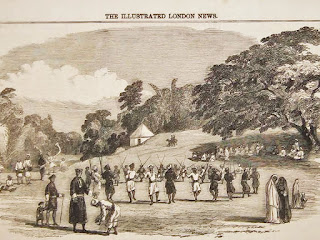Mookonda Nitin Kushalappa,
November 02, 2013, Saturday
November 02, 2013, Saturday
The word Puthari comes from Puth Ari meaning ‘new rice’. It is the harvest festival of the people of Kodagu. Formerly, Puthari was a week-long celebration. Paddy is harvested in the Kodava month of Birchyaar (around December, when the sun is in the zodiac sign of ‘Scorpio’) in Kodagu. Incidentally, Puthari is celebrated in North Malabar as well, three months prior to the Kodagu festival, because rice is harvested there in the month of Leo (around September).
The priest at Ammangeri village (near Padi Igguthappa temple in Kakkabe) decides the day and the muhurta (an ‘auspicious time’) of the festival based on his calendar and the appearance of the full moon. The festival is prominently celebrated at the temple of Padi Igguthappa. Houses are cleaned and painted before Puthari. On this day, a special dessert called Thambutt made from rice flour and mashed bananas (of the local mara bale variety) is prepared in Coorg homes. Each helping has grated coconut sprinkled upon it and a small hole made, in which a spoon of ghee is poured.
On the night of Puthari, around an hour after dusk, the nere kattuvo (ritual ‘tying of leaves’) ceremony takes place. Members of the family gather in their farmhouse. Leaves of certain trees are tied together, these are called the nere, and placed on a mat. This is followed by the kad edpo (ritual ‘cutting of paddy sheaves’) ceremony. They then go down to the fields in the moonlight where one woman carries a lamp. Everybody cries out Poli Poli Deva (‘May we prosper, O God!’). The eldest man of the family cuts an odd number of kad (paddy sheaves) and hands them over to other family members. They all then head back to the house where they place the sheaves before the prayer lamp. The youngsters then tie the nere at prominent places in the house. Firecrackers are burst later in the night. This is followed by feasting at dinner time.
The next day the mane paado (‘singing at houses’) ceremony takes place. Two or four singers with traditional hourglass drums, each drum is called a Dudi, go from house to house in the hamlet. These singers will sing and beat the drums at each house. Each song they sing eulogizes the members of that house. They are followed by youngsters of the hamlet. A few days later the people go to the Mand, the ‘traditional village greens’, in the evening and dance the Kolatta (the ‘stick dance’ or Dandiya).
The next day the mane paado (‘singing at houses’) ceremony takes place. Two or four singers with traditional hourglass drums, each drum is called a Dudi, go from house to house in the hamlet. These singers will sing and beat the drums at each house. Each song they sing eulogizes the members of that house. They are followed by youngsters of the hamlet. A few days later the people go to the Mand, the ‘traditional village greens’, in the evening and dance the Kolatta (the ‘stick dance’ or Dandiya).
